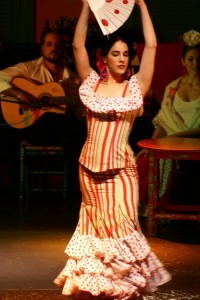
International Dance Week
Why wait until April 29th 2012 for World Dance Day? Put on your dancing shoes, let Explorica take the lead and one, two, three-step into this three-part series about some of the most culturally significant dances from around the world—Tango, Flamenco and the Cancan.
International Dance, Part 1—Flamenco
In this first of our three-part “blogisode,” get to know the rhythm of Spain through Flamenco, a dance chosen by UNESCO as a reflection of the cultural heritage and identity of the Spanish people. When we think of Flamenco we typically imagine Spanish Señoritas in ruffled spotted dresses rhythmically stomping their feet to the click of the castanet (a hand-held percussion instrument) alongside a tightly-suited Señor. But Spain’s national dance has been around since the 15th century, born as an assimilation of Islamic, Arabic and Andalusian gypsy folk culture when the area, now called Spain, was under Moorish rule. Some even believe that the word “Flamenco” means “Andalusian gypsy.” And the frilly Flamenco dresses of today are, in fact, an elaborate version of those worn by gypsy women who would accompany their husbands to livestock fairs to buy and sell cattle. A far cry from the glamour of modern Flamenco, which emerged at the beginning of the 20th century when Flamenco went professional and spectators parted with pesetas (old Spanish currency) to see a Flamenco performance in cabarets, cafés and theaters. Even upper-class ladies adopted the Flamenco dress for social events adorned with lace, ribbon and roses, and fitted them with secret pockets for carrying money. Visit Spain today and you’ll find Flamenco performed throughout the country. However, true Flamenco followers argue that much of what you’ll see on your travels is commercialized and doesn’t embody the true “duende” (or soulful emotion) of authentic Flamenco. So if you’re looking for the real deal, head to Andalusia in Southern Spain where Flamenco is not just a dance but an entire improvised art form that includes hand clapping, singing and guitar as well. And where the singer, rather than the dancer, is regarded as the central player in the performance. Olé!
Many of our tours to Spain already offer a Flamenco lesson, and nearly any itinerary can be customized either online or by calling a Program Consultant to add an authentic dance lesson to your tour.
